High-mass proto star clusters in and out of our Galaxy
Adam Ginsburg
Jansky Fellow, NRAO Socorro
Assistant Professor, University of Florida starting this fall
What is a high-mass cluster?
- Gravitationally bound collection of stars that survives the loss of gas, exhausting rather than expelling
it (Kruijssen+ 2012, Ginsburg+ 2016)
- Around \(10^4~\mathrm{M}_\odot \), \(v_{esc} \gtrsim10\) km s\(^{-1}\), so ionization alone does not disrupt gas
- Collection of coeval stars that 'fully samples' the IMF
- Extragalactically observable & countable objects, even in their protocluster state
NGC 253 protoclusters (Leroy+2018)
These protoclusters account for up to 100% of the starburst
NGC 253 protoclusters (Leroy+2018)
The extragalactic view of Galactic clusters
If you put Sgr B2 in NGC 253, it would be on the faint end of the detected clusters, but would be detectable.
ALMA gives a lot more detail in the Galaxy
ALMA gives a lot more detail in the Galaxy
Forming high-mass clusters in the Galaxy
- Galactic plane surveys find few (~10s) of high-mass protoclusters
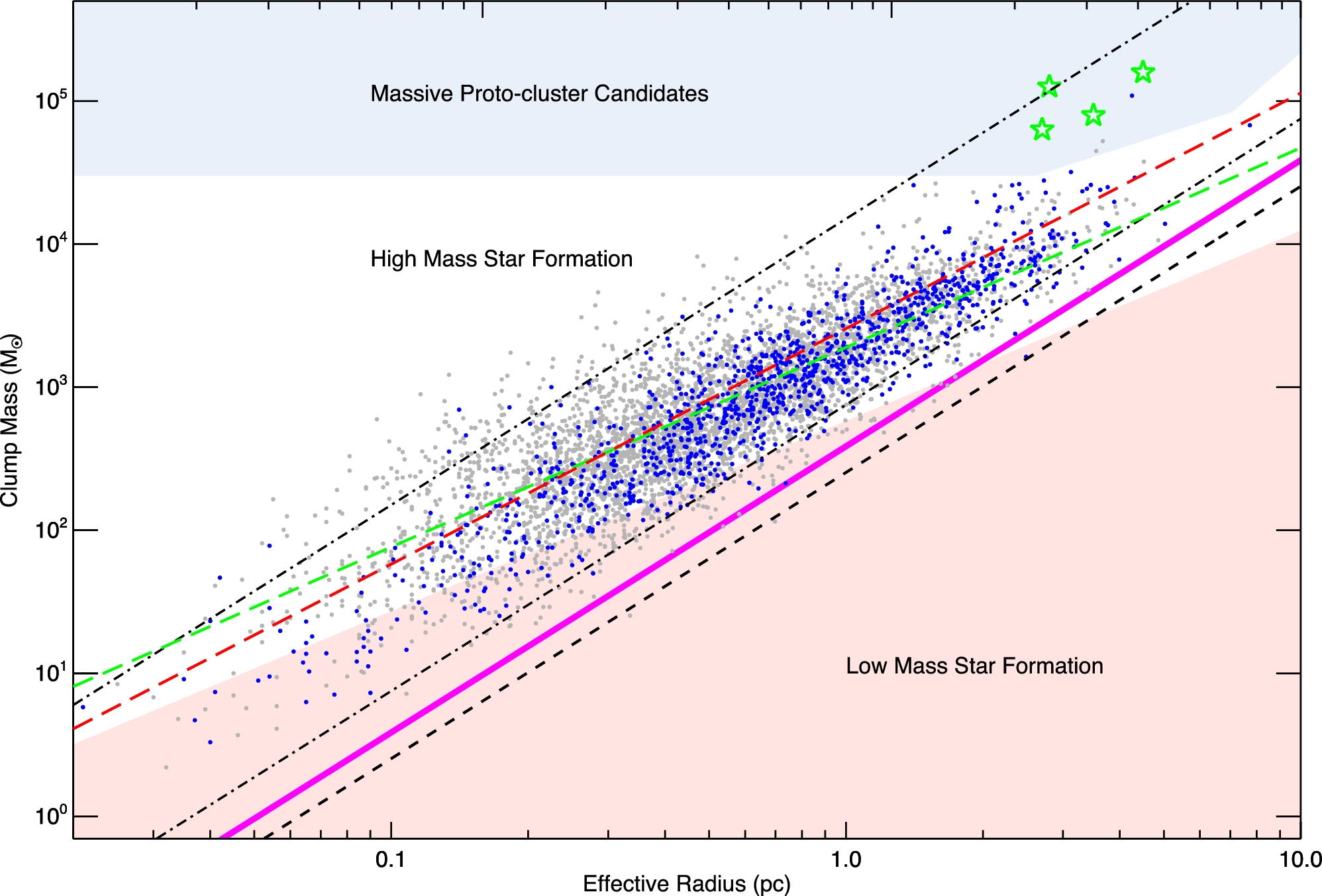
Extragalactic, molecular observations on pc scales
- Watanabe+ 2017 compared M51 to W51
- Galactic center datasets are available (https://github.com/CentralMolecularZone/DataSets)
- Mills+ 2018 did HC3N density measurements on pc scales
- Mills & Battersby 2017 did chemical comparisons on 100 pc scales
- W51 data are available (from me, published & unpublished on dataverse)
- LEGO survey is doing this for more clouds (W49, etc.) - Ash Barnes
- Today, for most Galactic comparison datasets, you need to find a paper and contact the author
ALMA surveys of Galactic clusters are becoming common
These programs create mosaics and include total power
data: they can be compared to parsec-resolution extragalactic
observations
- W51, Sgr B2 (Ginsburg+ 2017, 2018)
- W43, G10, G12, G328, G327, G333, G351, G353, G008 (ALMA-IMF)
- W49 (Galvan-Madrid+)
Example: W51
15% of the total continuum flux on \(\sim5\) pc scales
comes from three proto-MYSO hot cores, nearly all of the complex
molecule emission from the same three
(Ginsburg+ 2017)
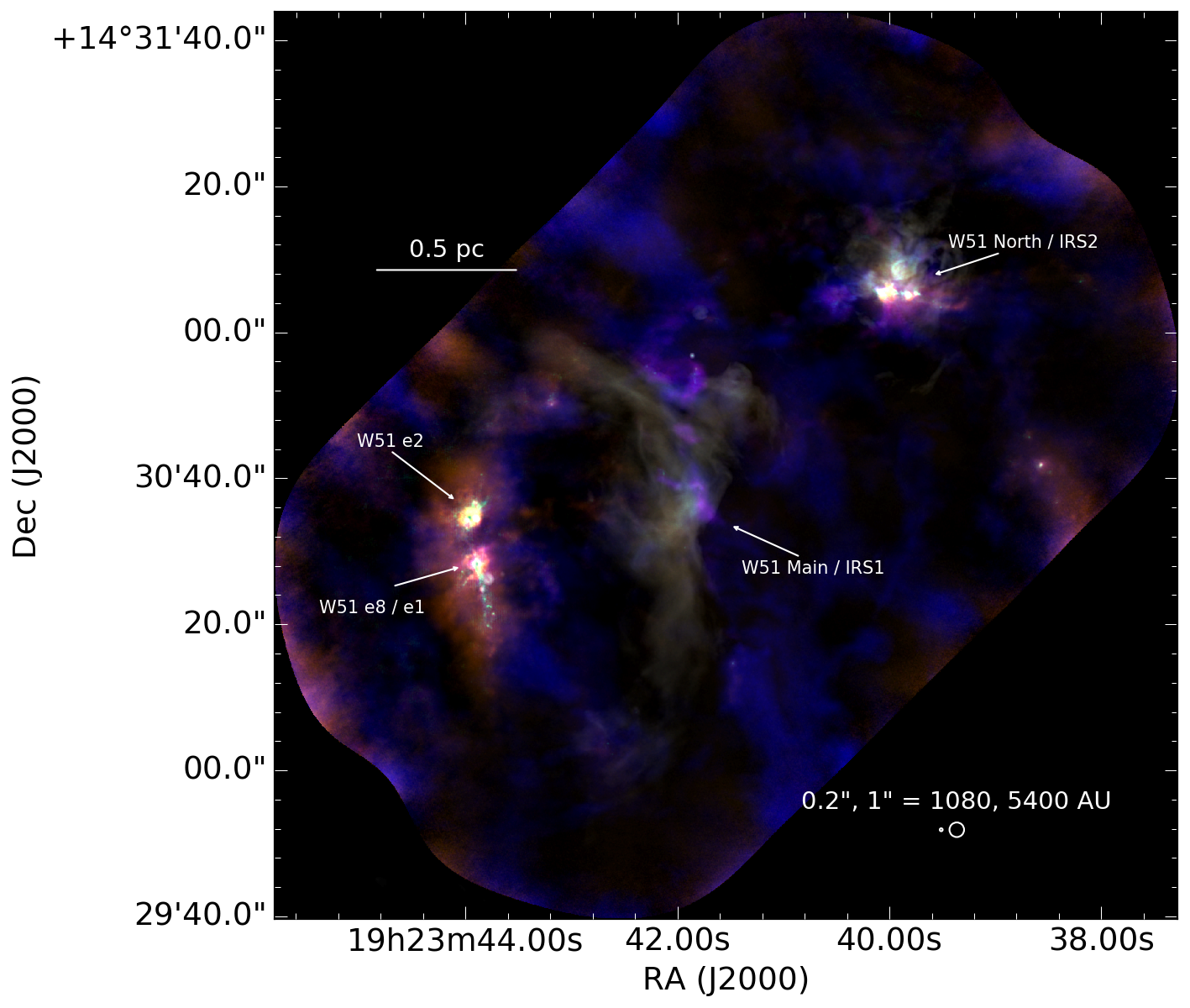
Sgr B2: Most massive cloud + protoclusters
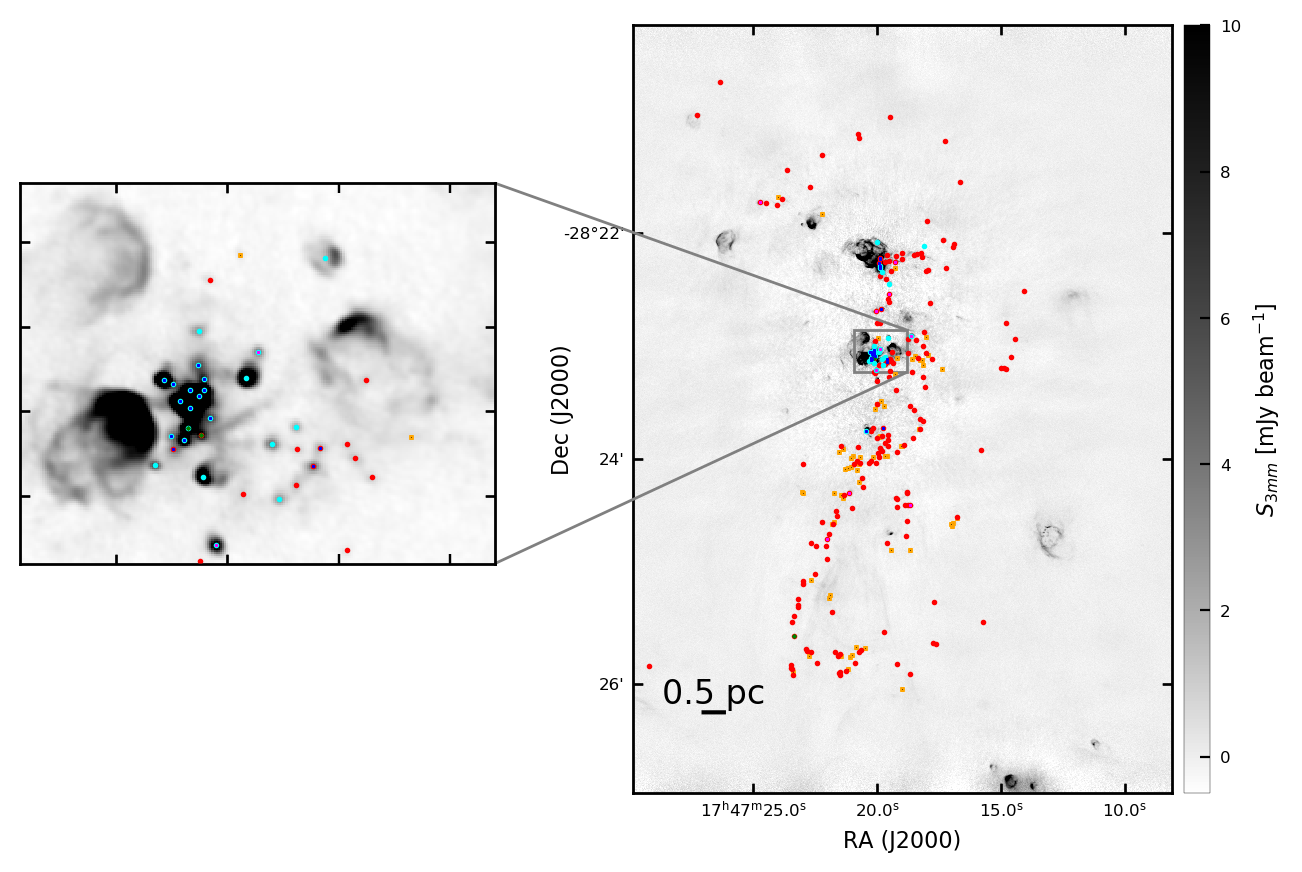
Tightly bound cluster: \(\sigma_{1D} \sim 9-12~\mathrm{km~s}^{-1} \)
\(\sigma_{1D} < v_{esc} \sim 14~\mathrm{km~s}^{-1}\)
from RRL LOS velocities
Clustered and unclustered star formation simultaneously
(Ginsburg+ 2018)
Sgr B2 N: Collapse
Collapse is morphologically obvious, but very difficult to measure:
continuum is optically thick on ~1000 AU scales
(Schwörer+, submitted)
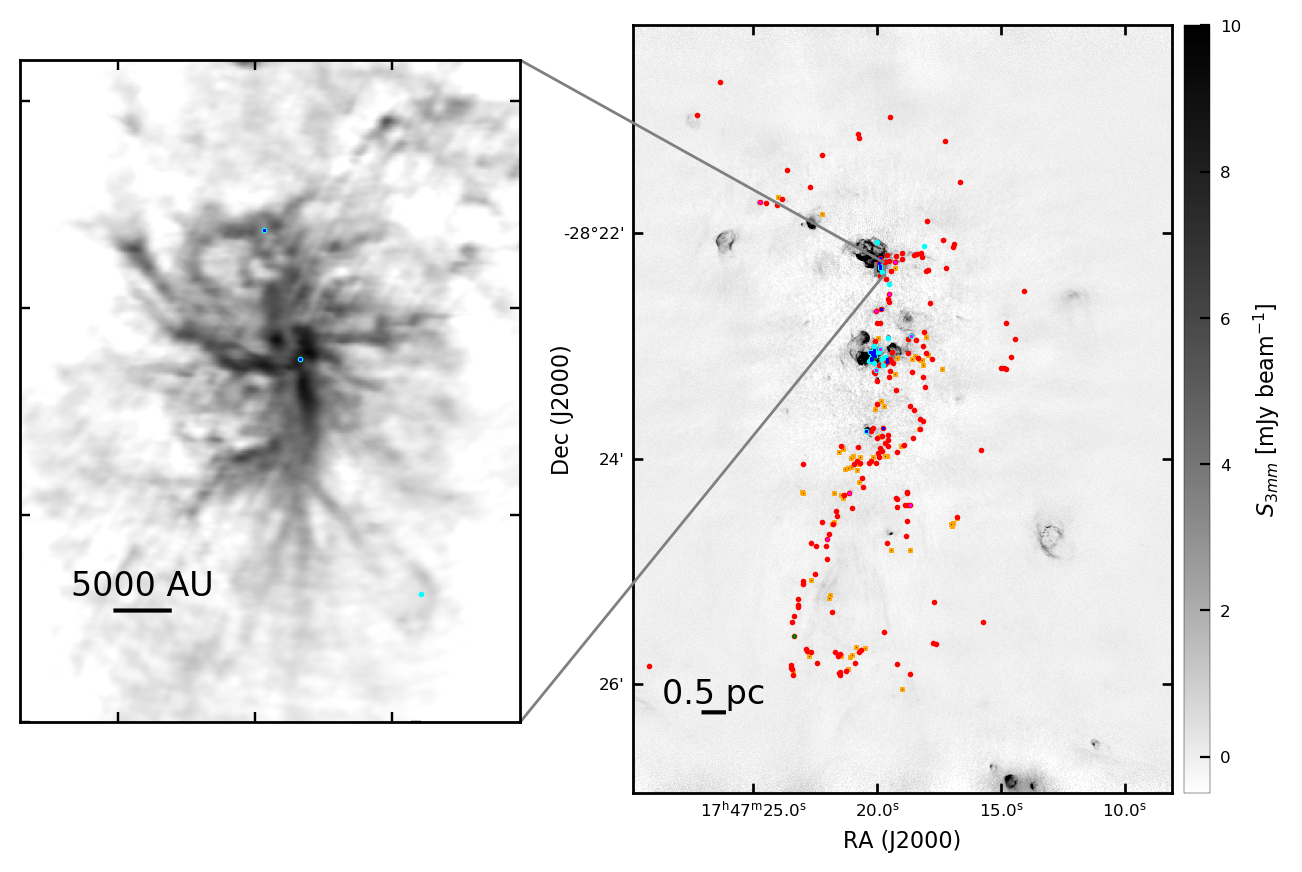
A closer look at Sgr B2 N
CH3OCHO: red, C2H5CN: blue, 242 GHz continuum: green
A closer look at Sgr B2 N
Schwörer+: Accretion along filaments
A closer look at Sgr B2 N
Schwörer+: Accretion along filaments: \(\sim0.1~\mathrm{M}_\odot \mathrm{yr}^{-1}\)
In denser (parts of) galaxies, more stars form in clusters
Γ is the fraction of stars forming in bound clusters
Galaxy averages
"Bound Cluster Fraction" is predicted higher the CMZ
Γ is the fraction of stars forming in bound clusters
Galaxy averages
CMZ prediction
The "Bound Cluster Fraction" is higher in the CMZ
Γ is the fraction of stars forming in bound clusters
Galaxy averages
CMZ prediction
Sgr B2 data
Sgr B2 data
Cluster Formation Efficiency: Feedback
- Feedback efficiency is strongly dependent on where stars form, i.e., on clustering
(Grudić & Hopkins 2018) - More concentrated stellar populations drive more neutral material out,
likely contributing to outflow (e.g., as seen in NGC 253)
(Kim, Kim, & Ostriker 2018)
Summary and looking to the future
- (proto)YMCs are detectable in nearby galaxies and observationally well-characterized in our own
- Cluster formation is more efficient in denser regions
- The link between Galactic and extragalactic observations is in chemistry and excitation:
Non-CO molecular observations on pc scales are the common ground that may allow extragalactic observations to pick out Galactic, ALMA-scale information
How many are there?
- SFR \(\times\) CFE:
\( \left(2~M_\odot~\mathrm{yr}^{-1}\right) \left(0.07^{+0.07}_{-0.03}\right) f_{(>10^4\mathrm{M}_\odot)} / \left(M_{cl,10^4 M_\odot}\right)\)\(= 3-12~\mathrm{clusters~Myr}^{-1}\)(Galactic CFE from Lada & Lada 2003, Goddard+ 2010, Kruijssen 2012; \(f_{(>10^4\mathrm{M}_\odot)} = 0.4\) )
- Observed: 12-18 currently forming YMCs
(excluding CMZ)- Fewer (~2) if more conservative SFE ~10% is used
- Observable protocluster lifetime ~0.2-1 Myr
- Kruijssen+ 2019: NGC 300, \(t_{fb}\sim1.5\) Myr
- Extragalactic censuses are more straightforward and likely more accurate
YMCs form fast
- Age spreads in YMCs are small, <1 Myr
- There are no signs of starless proto-YMC clumps
- Ginsburg+ 2012, Urquhart+ 2018
- Urquhart+ 2018 estimate the 'quiescent' phase is \(<2.4\times10^4 \mathrm{yr}\) for \(M>10^4 \mathrm{M}_\odot\)
- YMCs are gas-free by ~a few Myr
YMCs start large, collapse to small
- Gennaro+ 2017: Westerlund 1 is collapsing
- Walker+ 2015: gas is more extended than stellar cluster
Caveat: Sgr B2 is optically thick, might be much denser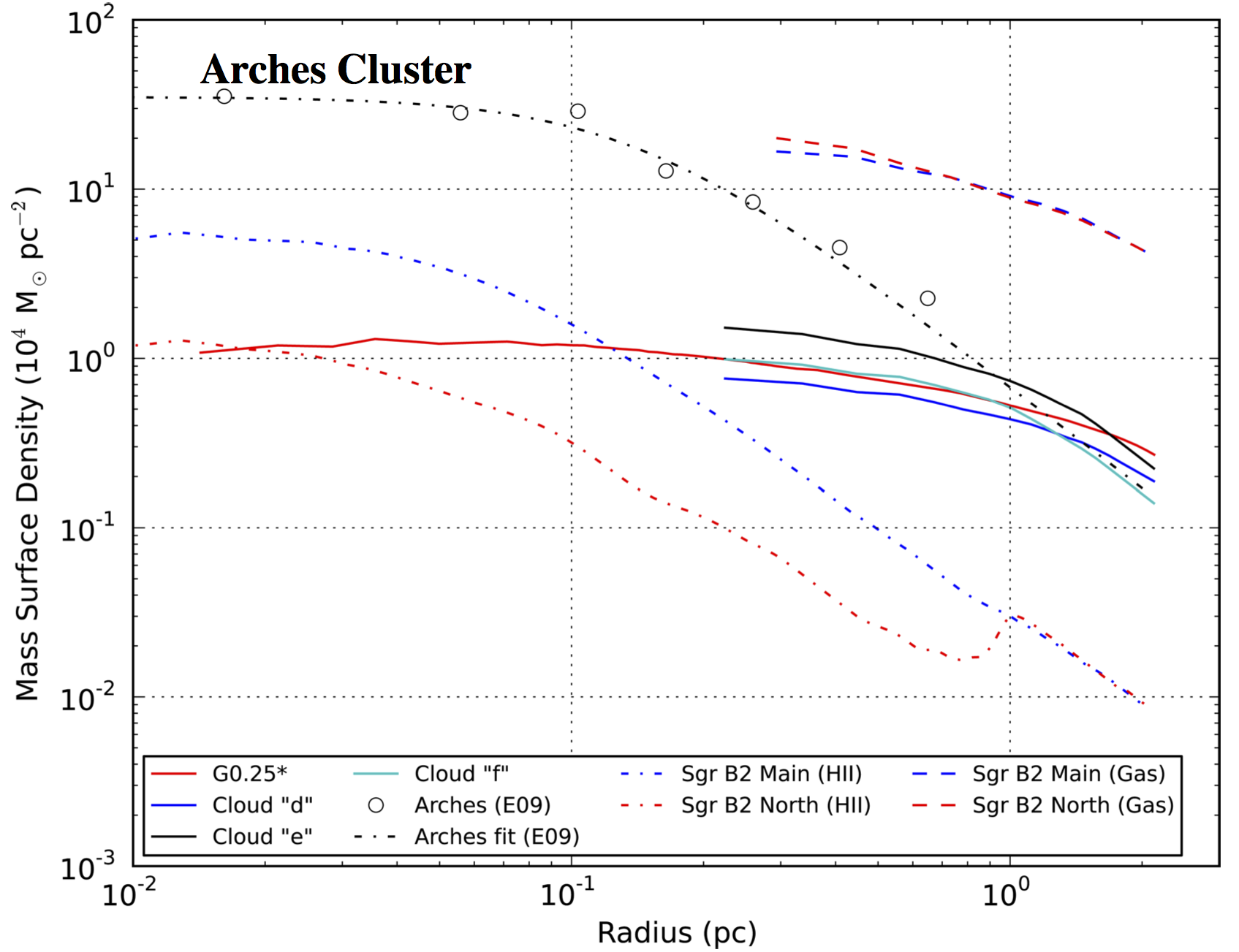
Feedback and Efficiency
- Feedback appears ineffective at halting SF on small, dense scales
- Ionization-bounded HII regions are smaller, less massive: HCHII regions ionize small amounts of gas that does not escape
-
For high \(v_{esc}\) regions, mass loss can only occur via stellar winds, jets, radiation pressure, and champagne flows
(e.g., Bressert+2012, Matzner & Jumper 2015)
- Winds are ineffective (Rosen+ 2014, Lopez+ 2014)
In simulations of smaller clouds, Geen+ (2018) found factor of ~3-5 variation in efficiency purely from IMF sampling stochasticityW51 IRS 2: Ionization is eroding gas inefficiently
Photoevaporation rate \(\dot{M}_{pe}< 0.001 \mathrm{~M}_\odot \mathrm{yr}^{-1}\)
Star Formation Rate \(\dot{M}_{sf}\sim \epsilon_{ff} M_{gas} / t_{ff} \) \(= 2000 \mathrm{M}_\odot / 10^4 \mathrm{yr}\) \(=0.2 \epsilon_{ff}\mathrm{M}_\odot \mathrm{yr}^{-1}\)
Even for \(\epsilon_{ff} = 0.01\), \(\dot{M}_{sf} > \dot{M}_{pe}\)
\(\dot{M}_{pe}\) consistent with Kim, Kim, & Ostriker 2018 for \(M_{cluster}\sim2-10\times10^3 M_\odot\)W51: X-ray stars
W51: X-ray stars
W51: X-ray stars + Cores and UCHII regions
W51: Cores and UCHII regions
- Observed: 12-18 currently forming YMCs